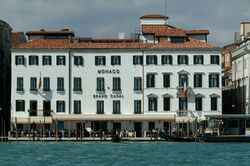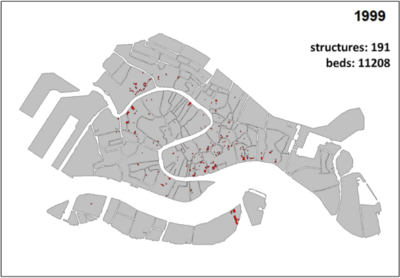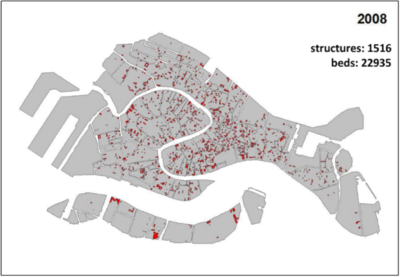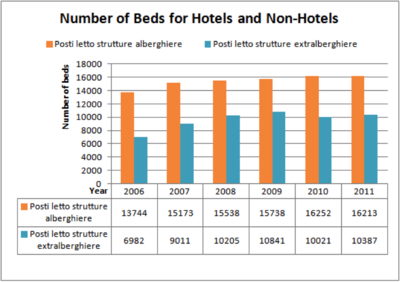Accommodations: Difference between revisions
No edit summary |
No edit summary |
||
| Line 46: | Line 46: | ||
===Tourist Accommodations in Venice=== | ===Tourist Accommodations in Venice=== | ||
Venice has experienced a steep increase in tourism over the past few decades. As a result, it has taken measures to ensure it has the necessary infrastructure to cope with the flood of people. The effects of tourism can be observed through the spread of tourist accommodations in Venice. As Venice’s appeal to tourists around the world increased, the need for new tourist accommodations grew. In fact, “without the swell of tourism, Venice –devastated by the French two centuries ago –might very well have vanished. The buildings along the Grand Canal that survived that cataclysm did so in large part because they were readily convertible to hotels and vacation rentals” <ref>McGregor, James H. 2006. Venice from the Ground Up. Cambridge, Mass: Belknap Press of Harvard University Press.</ref> Slowly and steadily, Venice started to transform and take new form through the development of the accommodation sector. | Venice has experienced a steep increase in tourism over the past few decades. As a result, it has taken measures to ensure it has the necessary infrastructure to cope with the flood of people. The effects of tourism can be observed through the spread of tourist accommodations in Venice. As Venice’s appeal to tourists around the world increased, the need for new tourist accommodations grew. In fact, “without the swell of tourism, Venice –devastated by the French two centuries ago –might very well have vanished. The buildings along the Grand Canal that survived that cataclysm did so in large part because they were readily convertible to hotels and vacation rentals” <ref>McGregor, James H. 2006. Venice from the Ground Up. Cambridge, Mass: Belknap Press of Harvard University Press.</ref> Slowly and steadily, Venice started to transform and take new form through the development of the accommodation sector. | ||
The high demand for tourist accommodations led to the rise of many hotels and bed and breakfasts. However, since Venice has seen its tourist levels increase from year to year, some residents have taken the opportunity to rent part of their houses to tourists in order to make a profit. In 1999 a new legislation, “Le Leggi Sul Bed and Breakfast Come Aprire un B&B in Veneto,” was created to regulate and also facilitate the creation of new bed and breakfasts and similar establishments <ref>Reg. Veneto. "Le Leggi Sul Bed and Breakfast Come Aprire un B&B in Veneto." Turismo e Strutture Ricettive. BU Veneto, last modified 26 October 1999, http://www.bed-and-breakfast.it/leggi_bed_and_breakfast_veneto.cfm.</ref> The city of Venice used this legislation to create more incentive to support tourism | <br> | ||
The high demand for tourist accommodations led to the rise of many hotels and bed and breakfasts. However, since Venice has seen its tourist levels increase from year to year, some residents have taken the opportunity to rent part of their houses to tourists in order to make a profit. In 1999 a new legislation, “Le Leggi Sul Bed and Breakfast Come Aprire un B&B in Veneto,” was created to regulate and also facilitate the creation of new bed and breakfasts and similar establishments <ref>Reg. Veneto. "Le Leggi Sul Bed and Breakfast Come Aprire un B&B in Veneto." Turismo e Strutture Ricettive. BU Veneto, last modified 26 October 1999, http://www.bed-and-breakfast.it/leggi_bed_and_breakfast_veneto.cfm.</ref> The city of Venice used this legislation to create more incentive to support tourism. | |||
==Changing Patterns in Tourist Accommodations== | |||
By making it easier for these establishments to be created, Venice made the accommodations market more competitive and promoted lower lodging prices. As a result, the number of accommodations in Venice increased a total of 793%, going from 191 to 1516 in nine years <ref>Carrera, Fabio. "The Harbinger of Alberghi." Venice 2.0., last modified April 18, accessed September 10, 2012, http://venice2point0.blogspot.com/2009/04/harbinger-of-alberghi.html.</ref> The number of B&Bs and rooms to rent alone have risen 1008% <ref>Mosto, Jane Da. 2010. The Venice Report: Demography, Tourism, Financing and Change of use of Buildings. Cambridge (Eng): Cambridge University.</ref> In 1999, there were only 191 tourist accommodations and a total of 11,208 beds in Venice in 1999. | |||
[[File:Number_of_hotels_and_beds_1999.png|thumb|center|400px|Hotels and Beds in 1999]] | |||
However, in 2008, only 9 years later, the number of tourist accommodations was 1,516 with a total of 22,935 beds throughout the city, as shown below. This increase represents an increase of over 87% in the number of accommodations and over a 50% increase in the number of beds. | |||
[[File:Number_of_hotels_and_beds_2008.png|center|thumb|400px|Hotels and Beds in 2008]] | |||
According to the Venice Report and the Comune di Venezia, the number of beds has increased a total of 18% for hotels and 49% for other accommodation establishments over the past 6 years. The expansion of tourist accommodations other than hotels is much more significant than the expansion of hotels. Indisputably this has taken away space that residents can oppupy. In fact, 44% of the 952 B&Bs opened 2001 – 2007 – 420 habitants – have been restructured internally so that they are no longer suitable for private occupancy” <ref>Mosto, Jane Da. 2010. The Venice Report: Demography, Tourism, Financing and Change of use of Buildings. Cambridge (Eng): Cambridge University.</ref> | |||
[[File:Number_of_beds_2006-2011.png|center|thumb|400px|Graph of Number of Beds 2006-2011]] | |||
==Consequences of the Increase in the Number of Tourist Accommodations== | |||
This drastic increase has had a negative effect in the city. According to the Venice Report, “planning laws have been liberalized to allow private homes to be turned into B&Bs and rooms to rent. On the one hand, this has ensured the maintenance of these buildings, on the other it has reduced the number of habitations available to residents by about 420 units and has contributed to the doubling of property prices since 2000, further encouraging residents to leave” <ref>Mosto, Jane Da. 2010. The Venice Report: Demography, Tourism, Financing and Change of use of Buildings. Cambridge (Eng): Cambridge University.</ref> Although there has been a significant decrease in the population and more properties have become available, real estate prices have been rising. Currenty, “property is exceptionally expensive in Venice, with a 1,000-square-foot apartment going for up to $1.3 million in the historic center, and more on the Grand Canal, but half or a quarter of that on the terra firma across the lagoon” <ref>Povoledo, Elisabetta. 2006. Vanishing Venice: A City Swamped by a Sea of Tourists. http://find.galegroup.com/gic/infomark.do?&source=gale&idigest=e2ec5eb891e9fec2746ebba219ddc64c&prodId=GIC&userGroupName=mlin_c_worpoly&tabID=T004&docId=A152139168&type=retrieve&contentSet=IAC-Documents&version=1.0</ref> Property prices, both for private and public properties, have steadily increased over the past decade. Since 2000, “there have been annual price increases of 11.21 per cent for residential property, 5.84 per cent for offices premises and 6.70 per cent for commercial premises such as shops” <ref>Mosto, Jane Da. 2010. The Venice Report: Demography, Tourism, Financing and Change of use of Buildings. Cambridge (Eng): Cambridge University.</ref> Since housing is cheaper across the lagoon, many residents have been leaving the city center to live on the mainland <ref>McGregor, James H. 2006. Venice from the Ground Up. Cambridge, Mass: Belknap Press of Harvard University Press.</ref> | |||
| Line 108: | Line 99: | ||
The NACE Coding System is a standard system used by the European Union in order to standardize how the data is categorized and to simplify the analysis of the trends in the stores and tourist accommodations in Venice. Some of the codes used for tourist accommodations are shown below. | The NACE Coding System is a standard system used by the European Union in order to standardize how the data is categorized and to simplify the analysis of the trends in the stores and tourist accommodations in Venice. Some of the codes used for tourist accommodations are shown below. | ||
*Affitacamere - H55.23.2 | *'''Affitacamere''' - H55.23.2 | ||
*Apartment Rental - H55.23.3 | *'''Apartment Rental''' - H55.23.3 | ||
*Bed and Breakfast - H55.23.1 | *'''Bed and Breakfast''' - H55.23.1 | ||
*Hostel - H55.21 | *'''Hostel''' - H55.21 | ||
*Hotel - H55.1 | *'''Hotel''' - H55.1 | ||
*Hotel with restaurant - H55.11 | *'''Hotel with restaurant''' - H55.11 | ||
*Hotel without restaurant - H55.12 | *'''Hotel without restaurant''' - H55.12 | ||
Revision as of 22:19, 9 January 2013
 Hotel Monaco and Grand Canal | |
| Basic Information | |
|---|---|
| Total Hotels in Venice in 2008 | 1516 |
| Total Beds in Venice in 2008 | 22935 |
| Types of Accommodations | |
| Apartment/Room Rentals | |
| Bed and Breakfasts | |
| Hostels | |
| Hotels | |
Accommodations, known in Italian as "alloggi", are any establishment that provides short-term residence for tourists in Venice in exchange for money. This includes hotels, bed and breakfasts, and parts of privately owned properties. The rise and expansion of the tourist accommodations throughout the historic center of Venice provides insight into the increase of tourism and helps explain how the economy has shifted from providing for the residents’ needs to attending to the tourists’ desires.
History
Tourism in Venice
Venice’s unique position on the lagoon has always attracted people to visit and admire it. Venice has catered to tourists from medieval to modern days. Tourism has thrived in Venice for hundreds of years, with Venice receiving a large and varied group of tourists every year. Even in the 1700s, people noticed Venice’s catering to tourists, saying, “Our gondoliers… rowed smoothly by the side of a broad pavement, covered with people in all dresses and of all nations” [1] For centuries, Venice has drawn foreign visitors and their money to itself. In order to care for all of these tourists, the accommodation industry has flourished with hotels and other accommodations flourishing, with a huge increase in the number of accommodations and number of beds that these accommodations contain.
Tourist Accommodations in Venice
Venice has experienced a steep increase in tourism over the past few decades. As a result, it has taken measures to ensure it has the necessary infrastructure to cope with the flood of people. The effects of tourism can be observed through the spread of tourist accommodations in Venice. As Venice’s appeal to tourists around the world increased, the need for new tourist accommodations grew. In fact, “without the swell of tourism, Venice –devastated by the French two centuries ago –might very well have vanished. The buildings along the Grand Canal that survived that cataclysm did so in large part because they were readily convertible to hotels and vacation rentals” [2] Slowly and steadily, Venice started to transform and take new form through the development of the accommodation sector.
The high demand for tourist accommodations led to the rise of many hotels and bed and breakfasts. However, since Venice has seen its tourist levels increase from year to year, some residents have taken the opportunity to rent part of their houses to tourists in order to make a profit. In 1999 a new legislation, “Le Leggi Sul Bed and Breakfast Come Aprire un B&B in Veneto,” was created to regulate and also facilitate the creation of new bed and breakfasts and similar establishments [3] The city of Venice used this legislation to create more incentive to support tourism.
Changing Patterns in Tourist Accommodations
By making it easier for these establishments to be created, Venice made the accommodations market more competitive and promoted lower lodging prices. As a result, the number of accommodations in Venice increased a total of 793%, going from 191 to 1516 in nine years [4] The number of B&Bs and rooms to rent alone have risen 1008% [5] In 1999, there were only 191 tourist accommodations and a total of 11,208 beds in Venice in 1999.

However, in 2008, only 9 years later, the number of tourist accommodations was 1,516 with a total of 22,935 beds throughout the city, as shown below. This increase represents an increase of over 87% in the number of accommodations and over a 50% increase in the number of beds.

According to the Venice Report and the Comune di Venezia, the number of beds has increased a total of 18% for hotels and 49% for other accommodation establishments over the past 6 years. The expansion of tourist accommodations other than hotels is much more significant than the expansion of hotels. Indisputably this has taken away space that residents can oppupy. In fact, 44% of the 952 B&Bs opened 2001 – 2007 – 420 habitants – have been restructured internally so that they are no longer suitable for private occupancy” [6]

Consequences of the Increase in the Number of Tourist Accommodations
This drastic increase has had a negative effect in the city. According to the Venice Report, “planning laws have been liberalized to allow private homes to be turned into B&Bs and rooms to rent. On the one hand, this has ensured the maintenance of these buildings, on the other it has reduced the number of habitations available to residents by about 420 units and has contributed to the doubling of property prices since 2000, further encouraging residents to leave” [7] Although there has been a significant decrease in the population and more properties have become available, real estate prices have been rising. Currenty, “property is exceptionally expensive in Venice, with a 1,000-square-foot apartment going for up to $1.3 million in the historic center, and more on the Grand Canal, but half or a quarter of that on the terra firma across the lagoon” [8] Property prices, both for private and public properties, have steadily increased over the past decade. Since 2000, “there have been annual price increases of 11.21 per cent for residential property, 5.84 per cent for offices premises and 6.70 per cent for commercial premises such as shops” [9] Since housing is cheaper across the lagoon, many residents have been leaving the city center to live on the mainland [10]
| Total Number of Apartment/Room Rentals | 10 |
|---|---|
| Total Number of Bed and Breakfasts | 30 |
| Total Number of Hostels | 2 |
| Total Number Hotels | 335 |
NACE Coding System
The NACE Coding System is a standard system used by the European Union in order to standardize how the data is categorized and to simplify the analysis of the trends in the stores and tourist accommodations in Venice. Some of the codes used for tourist accommodations are shown below.
- Affitacamere - H55.23.2
- Apartment Rental - H55.23.3
- Bed and Breakfast - H55.23.1
- Hostel - H55.21
- Hotel - H55.1
- Hotel with restaurant - H55.11
- Hotel without restaurant - H55.12
Reference
- ↑ Marqusee, Mike. 1989. Venice: An Illustrated Anthology. Topsfield, Ma: Salem House.
- ↑ McGregor, James H. 2006. Venice from the Ground Up. Cambridge, Mass: Belknap Press of Harvard University Press.
- ↑ Reg. Veneto. "Le Leggi Sul Bed and Breakfast Come Aprire un B&B in Veneto." Turismo e Strutture Ricettive. BU Veneto, last modified 26 October 1999, http://www.bed-and-breakfast.it/leggi_bed_and_breakfast_veneto.cfm.
- ↑ Carrera, Fabio. "The Harbinger of Alberghi." Venice 2.0., last modified April 18, accessed September 10, 2012, http://venice2point0.blogspot.com/2009/04/harbinger-of-alberghi.html.
- ↑ Mosto, Jane Da. 2010. The Venice Report: Demography, Tourism, Financing and Change of use of Buildings. Cambridge (Eng): Cambridge University.
- ↑ Mosto, Jane Da. 2010. The Venice Report: Demography, Tourism, Financing and Change of use of Buildings. Cambridge (Eng): Cambridge University.
- ↑ Mosto, Jane Da. 2010. The Venice Report: Demography, Tourism, Financing and Change of use of Buildings. Cambridge (Eng): Cambridge University.
- ↑ Povoledo, Elisabetta. 2006. Vanishing Venice: A City Swamped by a Sea of Tourists. http://find.galegroup.com/gic/infomark.do?&source=gale&idigest=e2ec5eb891e9fec2746ebba219ddc64c&prodId=GIC&userGroupName=mlin_c_worpoly&tabID=T004&docId=A152139168&type=retrieve&contentSet=IAC-Documents&version=1.0
- ↑ Mosto, Jane Da. 2010. The Venice Report: Demography, Tourism, Financing and Change of use of Buildings. Cambridge (Eng): Cambridge University.
- ↑ McGregor, James H. 2006. Venice from the Ground Up. Cambridge, Mass: Belknap Press of Harvard University Press.
External Links
See Also
| ||||||||